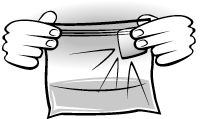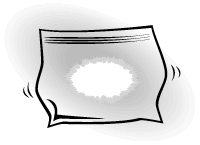|

|
 Now here's the tricky part.
You need to drop the time-release packet into the vinegar and zip the bag
closed before the fizzing gets out of control.
Now here's the tricky part.
You need to drop the time-release packet into the vinegar and zip the bag
closed before the fizzing gets out of control.
You can zip the bag halfway closed, then stuff the packet
in and zip the bag closed the rest of the way in a hurry. Or you can put
the time-release packet into the mouth of the bag and hold it up out of
the vinegar by pinching the sides of the bag. Zip the bag closed and then
let the packet drop into the vinegar.
One way or another, get the packet in the vinegar and zip
the bag closed.

|
|
|
|
|
 Shake the bag a little, put it
in the sink or on the ground, and stand back! The bag will puff up dramatically
and pop with a bang.
Shake the bag a little, put it
in the sink or on the ground, and stand back! The bag will puff up dramatically
and pop with a bang.
|

|
|
|

Why does the Bubble Bomb explode?
The bubbles in the Bubble Bomb are filled with carbon dioxide, a gas
that forms when the vinegar (an acid) reacts with the baking soda (a base).
If you've ever made a cake or baked a loaf of quick bread (the kind that
doesn't use yeast), you've already done some experimenting with the bubbles
that come from an acid-base reaction. Most cakes and quick breads rise because
of bubbles in their batter. Those bubbles, like the ones in your Bubble
Bomb, are created by the chemical reaction of an acid and a base.
Take a look at a recipe for quick bread. If the recipe includes baking
soda but no baking powder, it will probably also include an ingredient that's
acidic-such as buttermilk, sour milk, or orange juice.
Quick-bread recipes may call for baking powder in addition to or instead
of baking soda. Baking powder is made by combining baking soda with an acidic
ingredient, such as tartaric acid or calcium acid phosphate. When you add
water to baking powder, it will fizz as the acid and base interact. In fact,
if you ever run out of baking powder, you can make your own by mixing two
teaspoons cream of tartar (it provides the acid), one teaspoon of baking
soda (it's the base), and a half-teaspoon of salt.
|
|

-
Try using a different size of zipper-lock plastic bag. What do you
think might happen? Do you think you'll need to use more baking soda, vinegar,
and water to make the bag explode? Try it and see.
-
In the original experiment, we asked you to use warm water. Try using
cold water or hot water. Does changing the temperature change your results?
How?
-
The first time you tried this, you mixed the vinegar with water. Try
doing the experiment again with just vinegar. How did this change your
experiment?
-
Instead of using paper towel, make your "time release packet"
using a different kind of paper, like toilet paper, tissue paper or notebook
paper. What happened?

Any baked goods that rise rely on carbon dioxide bubbles to get the job
done. You can make these bubbles either by using yeast or by using the acid-base
reaction like you did in the experiment.
Yeast is a one-celled fungus which converts sugar to carbon dioxide gas.
Because this process takes a while, bakers use yeast in doughs that they
leave alone for several hours.
Another method that cooks use to make something rise is a combination
of baking soda and an acidic ingredient, like orange juice or buttermilk.
This is the same kind of chemical reaction that took place in your bubble
bomb.
Next time someone you know is baking, check the recipe to see if you
can figure out what ingredients make the bubbles that make the cake or bread
or cookies rise.

|
|
|

|
Published by Owl Books,
Henry Holt & Company, New York,
1996 & 1997
ISBN 0-B050-4536
&
ISBN
0-8050-4537-6
,
$12.95 each
|
|

© 1998
Exploratorium
|
|
|